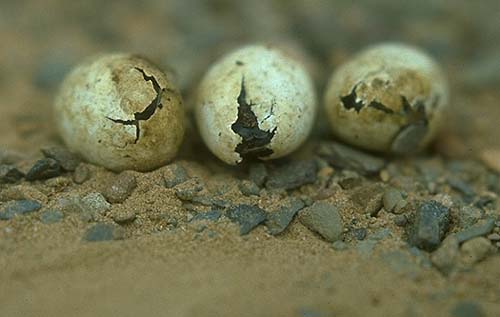The snapping turtle lives in the Hudson River.


Snapping turtles are aggressive creatures. Watch out! They snap at almost anything! These turtles are reptiles (cold-blooded animals that lay eggs). Although they often live in ponds or slow-moving streams, snapping turtles can also be found in the shallow areas of lakes and rivers.
 They prefer to stay underwater and bury themselves in the mud and sand. Adult "snappers" are
the biggest freshwater turtles and they can weigh more than eighty pounds! They have ridged
shells, webbed feet, and scaly legs. A snapping turtle also has a long tail and neck,
and it looks as though it's too big for its shell! This animal sometimes hides from its
enemies by pulling its head and legs into its shell. The shell offers good protection because it is strong and thick.
They prefer to stay underwater and bury themselves in the mud and sand. Adult "snappers" are
the biggest freshwater turtles and they can weigh more than eighty pounds! They have ridged
shells, webbed feet, and scaly legs. A snapping turtle also has a long tail and neck,
and it looks as though it's too big for its shell! This animal sometimes hides from its
enemies by pulling its head and legs into its shell. The shell offers good protection because it is strong and thick.
Snapping turtles are well adapted to their habitat. They can hold their breath and remain underwater for long periods of time. These turtles are nocturnal (because they look for food at night). During the day, you'll find the "snappers" either sleeping or hiding in the mud, waiting to attack the animals that they want to eat. At night, these creatures hunt both in the water and on the land. Snapping turtles are omnivores (animals that eat both plants and other animals). Their diet includes leaves, insects, earthworms, frogs, snails, and small fish. When the turtles capture a fish or frog, they swallow it whole!
 Late April and May is the mating season for snapping turtles. A female "snapper" digs a hole and lays her eggs in it. She carefully covers up the eggs because she doesn't want
other animals to eat them. Predators may also attack newborn snapping turtles.
Older turtles face danger when they try to cross roads or get caught in traps
set by hunters.
Late April and May is the mating season for snapping turtles. A female "snapper" digs a hole and lays her eggs in it. She carefully covers up the eggs because she doesn't want
other animals to eat them. Predators may also attack newborn snapping turtles.
Older turtles face danger when they try to cross roads or get caught in traps
set by hunters.
Where do snapping turtles prefer to live?
 |
Animal |
 |